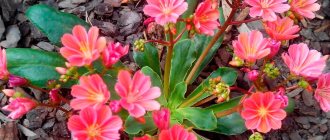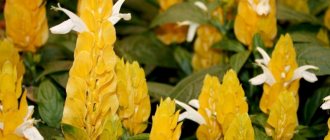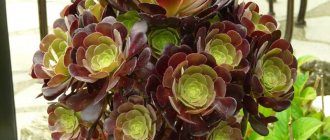Botanical description with photo
The Medinilla genus belongs to the Melamastaceae family.
Its homeland is the Pacific islands, as well as the Asian and African tropics. It can look like a vine, shrub or tree, has large leaves and inflorescences, but usually does not exceed 2 meters in height or length (for vines). It has an epiphytic or semi-epiphytic (starting on a tree and ending on the ground) type of development, therefore it can grow both on the ground and on trees or other plants. The leaves are a noble muted gray-green color with a wavy edge and sparse light-contrasting veins. In some varieties, the leaf blade is serrated, but more often it is solid; petioles are also not present in all varieties.
How it blooms
Beautiful flowers attract the most attention. They appear in spring on the tips of shoots or in the axils of leaves. The corollas are bell-shaped or tubular in shape and collected in dense racemose inflorescences. They are surrounded by large bracts that fall off some time after flowering begins. The core is lush, consists of elongated anthers and ovary. Flowering color can be white, soft pink, purple, salmon.
Where does it grow
In its natural environment, the plant lives in the tropics of Africa, on the islands of the Malay Archipelago and Madagascar.
The name of the plant is given in honor of Jose de Medinilla y Pineda, the governor of a Spanish colony. Medinalla came to Europe in 1850: it was planted in Veitch’s garden.
Planting and replanting indoor plants
Medinilla develops well and blooms in a slightly acidic substrate. The soil should be light, breathable and nutritious, consisting of peat, humus and sand. Ready-made soil mixtures are also used for rhododendrons and azaleas.
Since the flowers of this tropical beauty droop elegantly, tall pots are selected for it. To avoid stagnation of water, expanded clay and crushed polystyrene foam are placed at the bottom of the container in a layer of 3 cm.
Only tall pots are suitable for a tropical beauty
Young plants move annually, adults - once every 2-3 years. Replant after flowering and pruning, being careful not to damage the rhizome. Transplantation is carried out only when there is a need. Medinilla has a very sensitive root system, which should not be disturbed again. You can simply regularly replace the top layer of soil (5–7 cm) with fresh soil without changing the pot.
When buying in a store, pay attention to the stem - it should be green and without spots, the foliage should not show signs of yellowing. A healthy plant must be transplanted into new soil, giving it several hours to adapt to new conditions. Pre-wash the leaves with warm water, washing off the preparations that are used to treat the plants before sale. The earthen lump should dry thoroughly.
When replanting, pay attention to the root system
- The pot is selected 5 cm larger than the previous one.
- Drainage is laid at the bottom with a layer of 3 cm. Expanded clay, gravel, and pieces of bark can be used as drainage material.
- Carefully remove the tender plant from the container.
- Inspect the roots - they should be light, without damage.
- Remove the top layer of soil from the clod.
- Place in a pot and cover with new substrate.
- Water and spray.
If there are a lot of flowers, they put up supports so that the shoots do not break off, and carefully tie powerful stems to them. You can grow medinilla in an ampelous form in hanging baskets, vessels on pedestals, stands and picturesque stools.
You can grow medinilla as an ampel in pots on pedestals
Main types
Flower growers grow a limited number of species. The most famous are the following.
Medinilla Magnifica
It is also called medinilla splendor. It is considered the most common species in home floriculture. Her homeland is the Philippine Islands.
Breeders, taking Medinilla Magnifica as a basis, obtained varieties such as:
- Dolce Vita - has massive clusters of pink inflorescences.
- Bello is a miniature medinilla variety. Has a short flower brush.
Gorgeous
- Jadore Trezor is a representative of a low-growing variety. It has white-purple or unusual bluish flowers.
Medinilla Jadore Vita
The second most common species in home floriculture, which is a hybrid based on Medinilla superb (Magnifica). It blooms even more decoratively in a muted pink palette; the bracts are multiple, narrowed in shape.
This is interesting! In 2012, a new variety of medinilla was discovered, which has so far been found in nature in only one single specimen on the island. Fiji.
Medinilla veinata
Veinous melastoma is the second name for medinilla. Her homeland is Malaysia. The plant has aerial roots that descend to the ground. Therefore, veined medinilla is considered a hemiepiphyte.
Veined
The leaves of this species of medinilla are small, with a bristly surface and a sharp tip. The inflorescences are flesh-colored and umbrella-shaped.
Medinilla Cuminga
This species of medinilla is native to the Philippines. This is a semi-epiphyte. The leaves are shiny and slightly concave.
Kuminga
Medinilla inflorescences look like clusters of pink flowers, reminiscent of lilacs.
Medinilla java
One of the popular types of medinilla common in indoor floriculture is Javan. The flower is unpretentious in care, has the appearance of a small shrub up to 1 meter high. Javanese blooms with small lilac-violet flowers on racemes. It is not particularly decorative due to the fact that it does not have bracts.
Medinila Javanese
When purchasing medinilla from a flower shop, you need to carefully examine it. If dark spots are found on the stems, this indicates a sign of plant disease. Experienced flower growers who breed medinilla varieties do not recommend buying discounted plants. If a plant is discounted, it means something is wrong with its health. In this case, money will be wasted and there will be no pleasure from the purchase.
Common care mistakes and how to eliminate them
Medinilla reacts strongly to the grower's mistakes. Even minor, from your point of view, deviations from the norm in temperature and humidity can lead to some kind of problem with the health or appearance of the flower. Let's try to figure them out together. In the table we have indicated some flower care mistakes:
| Care errors | Consequences | How to fix |
| The indoor climate is dry. | - new leaves will become small; - the leaf blades will dry out or curl; - the plant will not bloom. | Use all available methods to increase the humidity of the surrounding air: spraying, containers with water, trays with wet moss or expanded clay, household humidifiers, wet towels on radiators - everything comes into play when you need to help your green friend. |
| Lack of lighting, drafts, moving the pot to another place. | - formation of a small number of buds or their complete absence - fall of flowers and buds. | It is necessary to organize additional lighting, avoid drafts and not move the pot while medinilla is flowering. |
| Excessive lighting, the flower is in direct sunlight. | - light spots will appear on the leaves. | Protect the bush with blinds or light curtains, or move it away from the window slightly into the back of the room. |
| The room is cold (radiators are not heated in autumn). | - the leaves will dry out; - the leaves and stem will turn black. | Reduce watering. The top layer of soil should dry out 2-3 cm between waterings. Raise the air temperature in the room to the desired level using electric heaters. |
| Frequent and abundant watering of the soil allows stagnation of water in the pan. | - spots will appear on the leaves; - the root system will rot. | Watering rates need to be adjusted. But first make sure that nothing has happened to the roots. Remove the flower from the pot and inspect the roots. Rotten and damaged - cut with a clean, sharp tool. Treat wounds with crushed coal or ash. Replant into a new substrate according to all the rules. Don't fill it up. If it seems to you that the soil is dry and the time for watering has not come, spray the foliage generously. |
| Medinilla is not provided with a period of rest. | - the plant will not bloom profusely next season | Do not forget to provide the flower with proper wintering. |
Medinilla: home care
The most preferred variety for growing indoors is Medinilla Magnificent; care is quite complicated, but following the right advice, you can create conditions as close as possible to its natural habitat.
Soil composition
Instructions for caring for medinilla include choosing the correct planting mixtures. The substrate should consist of leaf humus, turf, sand and peat soil in a ratio of 2:2:1:1.
You can purchase ready-made soil at flower shops. The main thing is that it is loose and slightly acidic. Drainage must be placed at the bottom of the pot to prevent moisture stagnation and root rotting.
Temperature
It is recommended to maintain the temperature above twenty-five degrees. In the warm season, the temperature should not fall below twenty degrees. Remember - the plant’s homeland is the tropics and medinilla reacts extremely negatively to cool conditions. The only exception is the dormant period, which lasts from December to February. At this time, the flower rests and gains strength. During the rest period, the recommended temperature is in the range of 15-17 degrees. The plant reacts very negatively to sudden temperature changes, and the most dangerous factor is drafts.
Location
Growing medinilla at home comes with some challenges. The plant must be provided with conditions as close as possible to its natural habitat.
Proper care includes positioning near windows facing west or east. The south side is also suitable, but in this case you should take care of shading - the burning rays of the sun are destructive to the leaves.
The first sign of insufficient lighting is the lack of flowering and the shedding of unopened buds. The problem can be solved by resorting to additional lighting with phyto- or fluorescent lamps.
Lighting
Medinilla will delight you with flowers only if there is enough light. Bright diffused light is recommended, but with mandatory protection from direct sunlight. In winter, it is necessary to compensate for the deficiency with artificial sources; fluorescent lamps or special phytolamps are suitable. The most preferred location for the plant is windows in the east or west of the room. When kept in the south, mandatory protection from direct sun is required.
Fresh air
Medinilla does not tolerate drafts or stagnant air. She needs freshness, but without cold. Frequent ventilation should be done so that the flower does not become overcooled. The situation is complicated by the fact that the crop extremely dislikes rearrangements and even rotations relative to the light source during flowering, so ventilation should be provided in such a way that the flower stands still, but does not suffer from cold air masses. As a result, it quickly stops flowering and sheds the already open buds, and then the leaves.
Medinilla is so intolerant of drafts that it will suffer even in places where people walk close to it, causing air masses to move.
Air humidity
The flower is very moisture-loving and the main problem is maintaining indoor humidity at least 70%. During the day, spraying with a fine spray bottle is recommended, but try not to get it on the flowers. The water must be warm and pre-settled. A good option would be to place trays of water or wet pebbles near the flower. You can use indoor fountains or humidifiers.
In winter, it is imperative to protect the flower from the heat of heating systems. The batteries can be covered with a damp sheet or towels. With a lack of moisture, the plant’s development is greatly inhibited, the leaves lose their decorative appeal and begin to shrink.
Watering
During the active growing season, the plant requires regular moderate watering. Focus on the condition of the top layer of soil in the pot; it should have time to dry out by about two or three centimeters. With the arrival of cold weather, water less frequently, and when entering the dormant period, water only after the soil has dried thoroughly.
Water with soft, settled water, the temperature of which should be several degrees higher than the room temperature. Experienced florists advise using filters for cleaning. It is important not to overwater the plant, especially in cool conditions. The root system is very sensitive and prone to rotting when overwatered.
Fertilizer
The flower needs regular feeding, but only during the period of active growth. In the summer, you can use organic fertilizers a couple of times, but the basis of feeding should be preparations for ornamental flowering plants. The frequency of application should not exceed two or three feedings per month. In the cold season, feeding is not required; it is especially not recommended to apply fertilizers during the resting period of the plant.
Bloom
At the end of winter, the plant wakes up - new leaves grow, and in April, flower stalks. The period of appearance of buds and opening of flowers is long, about one and a half months. The flowering itself lasts the same amount of time. The flowers have no smell.
Medinilla Cuminga has flowers collected in racemes
The arrow of the peduncle with faded flowers should be trimmed - this stimulates the appearance of new inflorescences. After flowering, the stems on which there were flowers are shortened by half.
Medinilla magnificent flowers hang beautifully on long peduncles from the green mass of the bush
If the medinilla does not bloom, it means that it was not cared for correctly in winter.
Transfer
Young flowers are replanted every year; adults only need to replant them once every couple of years. The soil should be sufficiently loose and nutritious. You can use purchased soil mixtures for epiphytic plants, but experienced florists recommend preparing the soil yourself. For self-preparation, use equal proportions of peat, coarse river sand and humus soil. The prepared soil must be diluted with twice as much leaf and turf soil. The bottom of the dish must be equipped with good drainage. Quick removal of excess liquid is the key to a healthy plant root system.
Transplant instructions
- Place a drainage layer at the bottom of the pot; its height depends on the size of the container.
- Place some soil on top of the drainage and moisten it.
- Remove the plant from the old pot without destroying the soil with its roots.
- Inspect the roots; if there are rotten ones, carefully remove them.
- Move the plant to a new pot.
- Gradually fill the earthen ball with fresh soil, slightly compacting the void between it and the wall of the pot. Medinilla does not like dense soil.
- Water the plant a little, spray it and place it in a permanent place suitable for the conditions.
Changing the pot does not bother Medinilla, but it is better to support her with feeding. Add a rooting preparation (Kornevin, Zircon, Ecogel) to the irrigation water once a week. Spray the plant with a very fine sprayer with Epin solution (2-3 drops per glass of water).
Rest period
From November to February there is a period of rest. At this time, flower buds are laid. This is why winter conditions are so important. The plant is moved to a cooler place (+15–17°C) with bright lighting, watering is reduced, but the soil is not allowed to become too dry. If medinilla does not receive enough light during the winter months, it may not bloom in the future. Therefore, in a dark place it is necessary to additionally use lighting devices, for example, fluorescent lamps.
Trimming
After flowering and during replanting, prune shoots that are too long, remove yellowed leaves and wilted inflorescences.
Plant support
Medinillas are often grown in an ampelous form. In hanging pots or baskets, the plant will not need support; the shoots and brushes with flowers hang freely.
It is better to install the support in the pot in advance, while the plant still holds its shape.
But, if a medinilla bush grows in a pot on a stand, over time it may “fall apart”. The stems, weighed down by a massive crown, begin to bend. Prevent the problem at the very beginning by placing a cone-shaped support in the pot. This can be a design from a store or made independently. For example, place bamboo sticks around the circumference of the pot and connect them with flexible wire or twine. The main thing is not to allow the shoots to deviate significantly from the vertical.
Watering
This moisture-loving plant should be regularly watered with soft, settled water at room temperature. Even slight drying of the soil will lead to the tips of the leaves drying out and the flowers dropping. During the formation of buds, the soil must be kept moist at all times. But do not allow a swamp; excess water from the pot should flow freely into the pan, from where it should be removed in a timely manner. During flowering, the intensity of watering is slightly reduced, and during dormancy, it is completely reduced to a minimum and watered only after the soil in the pot has dried by half. The rule here is that the lower the temperature, the less frequent the watering.
This may be interesting: Diseases and pests of gloxinia - how to deal with them
Reproduction
Propagating medinilla is no less difficult than caring for it. Two methods are used: cuttings and sowing seeds.
Reproduction by cuttings
Cuttings are taken from March until the end of spring. As a cutting, you need to take a semi-lignified stem, which has 2-3 internodes. Treatment with root formation stimulants is mandatory. Rooting occurs only at high humidity and a temperature of approximately 28-30°.
Attention ! It is clear that in such conditions cuttings often rot, so the rooting percentage is low.
The substrate in the greenhouse should consist of a mixture of peat, sand and perlite. If everything went well, roots will appear in a month and a half. A cutting that begins to sprout should be pinched to stimulate crown formation. In the future, pinching is not needed.
Make the picking after the appearance of two true leaves, planting the cuttings in separate small pots. Make a transshipment next spring.
How to properly take medinilla cuttings?
Cuttings can be taken from January to May. To do this, you should choose strong, healthy, semi-lignified shoots. Each cutting should have 2-3 internodes, usually for this you need to capture a part of the shoot 8-10 cm long. The lower cut is made obliquely, then it is eavesdropped and treated with “Kornevin”. For rooting, the cuttings are stuck with a sharp end into a light, for example, peat-sand soil mixture, after which an atmosphere of artificial fog is created (high humidity and temperature within + 25C). When the cutting takes root and sends out its first shoots, they must be pinched to stimulate the growth of side shoots. After this, you can plant in a permanent container.
Propagation by seeds
Planting material can be bought at a gardening store or on the Internet; a bag usually contains only 5 pieces. Medinilla seeds look like small coffee beans. They are sown in February or March. Proper care of medinilla begins with the right choice of pot. The container should be wide and shallow. It is recommended to take turf soil mixed with sand as a substrate. Embedment depth - 5mm. The surface of the soil is moistened with a spray bottle and covered with film. It is necessary to ensure bottom heating of the dishes with planted seeds. It is necessary to open the film, monitor soil moisture and remove condensation daily. Shoots should appear in about a month. The cover is immediately removed, and after the formation of the 2nd true leaf, it is picked into separate cups filled with a mixture of leaf soil and sand. Further growth of seedlings should occur in conditions of high humidity; drying out of the soil is not allowed. Transplantation into a permanent pot is carried out after the appearance of 5-6 leaves using the transshipment method.
Medinilla transplant
The young plant is replanted every year. When it grows, the number of transplants is limited to once every 3 years. The time of each procedure is the beginning of spring.
For each planting, it is necessary to prepare soil saturated with essential nutrients. If you couldn’t find a suitable substrate in the store, you can make it yourself: peat, sand, humus, tree bark, turf, deciduous soil. The ingredients are mixed in equal proportions.
Diseases and problems
Thus, the biggest difficulty in caring for medinilla is maintaining high humidity. When it is insufficient, the leaves become smaller, brown or dry, and flower buds do not form. At the same time, with high humidity, combined with stagnant air, various fungal diseases easily develop.
In autumn, and especially at the end of winter, in March, you need to illuminate the plant with lamps to lengthen daylight hours. Without this, flowering may also not take place.
Also try not to change the place usual for the flower. When changing it, medinilla may lose not only flower buds, but also some of the leaves.
Among the pests, it is damaged by scale insects, thrips, scale insects, and spider mites. Control measures are standard, using appropriate drugs.
Possible growing problems
There can be many problems, but the most important one is that any mistake can become a blunder with irreparable consequences. If you notice the negative development of the scenario in time, in some cases you can manage to correct it.
- Medinilla does not bloom or produces ugly, deformed inflorescences. The plant lacks either light, or air humidity, or heat, or all this is in the wrong combination.
- The flower has dropped its buds and leaves - it was moved to another place during flowering or placed in a draft.
- Young foliage becomes smaller and thinner, old foliage curls - the air is too dry.
- Unsightly white or brown spots appear on the leaves - spraying with hard or chlorinated water.
- The leaves darken and lose their fresh color - the soil is waterlogged.
Medinilla leaves are drying up
Medinilla leaves dry photo What to do
Botrytis (grey rot) is a fungal disease that occurs when the soil is over-moist. Gray spots appear on the stems and leaves. It is necessary to remove the affected areas on the leaves and roots, replant them in clean soil and treat with a fungicide: water and spray with a solution of phytosporin. Repeat 2-3 times after 10 days.
Medinilla pests
Mealybug, spider mite, aphid, scale insect. They settle on leaves, feeding on their juice. If you find pests, moisten a cotton pad with soapy water and wipe the leaves. Then treat with an insecticide.
Medinilla leaves are falling off
Lack of care can affect the plant:
- When the air is dry, the leaves become smaller and curl.
- If the medinilla is stressed, it may shed its leaves. This could be a change of location, a draft.
Medinilla does not bloom
Flowering is absent for a number of reasons:
- Low humidity level
- Lack of lighting
- Low air temperature
- No dormant period in winter (with cool maintenance and reduced watering).
Flower location and lighting
It is known that medinilla feels equally bad both with a lack of sunlight and with prolonged exposure to sunlight. But the plant simply needs oblique rays of the sun in the mornings and evenings. Based on this, you will select a suitable place for the flower on the south side of the apartment, slightly in the back of the room. If you place it on or near a windowsill, be sure to shade the plant with light curtains or blinds during the midday. Otherwise, irradiated with ultraviolet rays, the plant will get sick or even die.
Windows in eastern and western directions are also suitable for medinilla, but in the autumn-winter periods it will require illumination with artificial lighting lamps or a phytolamp. The plant needs at least 12 hours of daylight. It should be remembered that the distance from the lamp to the crown should not be closer than 60 cm, otherwise you will burn the delicate leaves and inflorescences. Northern windows are not suitable for a flower, because even in summer there will not be enough sunlight for it.
The pot of medinilla should always be in the place you choose. It is not advisable to rearrange it, and during flowering it is simply unacceptable. When choosing its place of residence, take into account the fact that the plant does not tolerate drafts and hot air near heating devices in winter.
Florarium
Some gardeners grow medinilla in florariums. A florarium is a composition of living plants grown in a glass terrarium. It could be an aquarium, a glass, a jar. In addition to plants, there may be various decorative elements: beautiful pebbles, pieces of driftwood, shells. In such a home greenhouse, medinilla will feel great, provided it is a compact variety or is still very young. For example, a dwarf species, Medinilla sedumifolia, grows well in a florarium, where a soft microclimate with high humidity is created for it.
You can read about medinilla sedumifolia, as well as many other types and varieties of medinilla here .
A home florarium is not suitable for tall and spreading specimens. You will need a large transparent enclosure (showcase or window) with special equipment for watering, lighting, ventilation and bottom heating. Such a structure is not cheap, so it is rare.
Recommendations for a successful purchase
Dear beauty is very capricious. Not a single photo will show the incredible efforts of the gardener spent on care at home and monitoring the condition of the medinilla. Therefore, it is a rare seller who regularly grows it for sale. But those who want to try can find seeds in the public domain and purchase them at a very affordable price.
It is not recommended to order seedlings or adult flowers via postal delivery. This delivery method can damage the plants, causing them to become sick and die quickly.
The best time to purchase medinilla is the spring and summer months. This should not be done during winter. Sudden changes in temperature negatively affect the plant, affecting it with fungus. At the time of purchase, experts advise carefully examining the external condition of the medinilla. Any deficiency indicates a flower disease.
Bloom
Medinilla usually blooms in late spring - early summer. Flower clusters bloom gradually and also gradually fade. Flowering can continue and last up to two months, sometimes longer. The flowers have no smell.
Young bushes willingly grow flower stalks, but you should know that abundant flowering weakens young plants, so excess buds are removed from them. To ensure the buds open, do not move the pot to another place. Don't even turn it the other way towards the sunlight. During flowering, spray the flower with extreme caution. Do not spray onto flower brushes. Due to water droplets, flowers and buds may darken and fall off.
This may be interesting: Methods for propagating Balsam
It is better to remove peduncles with faded flowers in order to stimulate the appearance of new inflorescences and not spoil the appearance of the bush. Medinella sometimes sets fruit at home. If the peduncle remains, maybe you will see its fruits, which are no less decorative than the inflorescences.
What happens when a flower is not cared for correctly?
Even the most minor changes in the environment or care are immediately reflected in the condition and appearance of the tropical capricious one.
A less capricious plant is the peacock flower or episcia. You can learn about the conditions for its cultivation from the material:
Maintenance errors and what to do to eliminate them - table
| Errors | How to fix the situation |
| The plant does not bloom, the new leaves are small. | The microclimate is too dry. Increase air humidity, spray the bush as often as possible. |
| Falling off of buds and flowers. | Reasons: short daylight hours, drafts, movement of the flower. Use additional lighting, protect from drafts, do not move the pot. |
| Light spots on the leaves. | Occurs as a result of excessive lighting. It is necessary to shade the bush from the bright sun. |
| In winter, the foliage dries out. | Reasons: very cool room, waterlogging. Raise the temperature in the house and let the soil dry out. |
| The leaves dry out in summer. | The apartment is hot and dry. Maintain the air temperature no more than +25, spray the leaves. |
| Blackening of the stem and leaves. | The plant suffers from excess moisture and cold. Establish proper watering, moisten the soil only after the top layer of soil has dried. Maintain optimal temperature values depending on the season. |
Bright rays of the sun cause leaf burn











